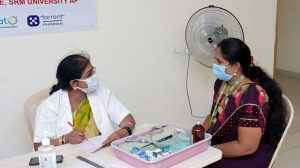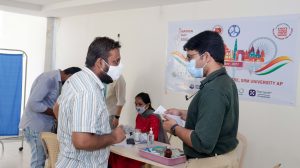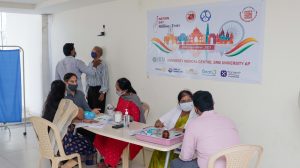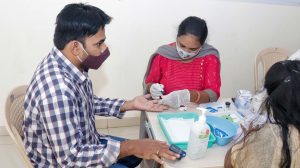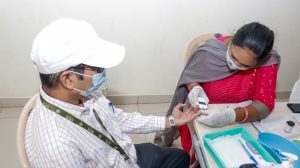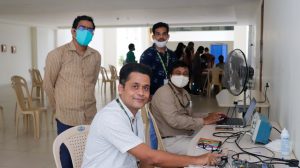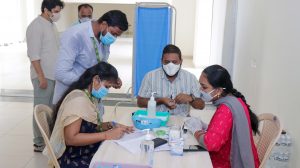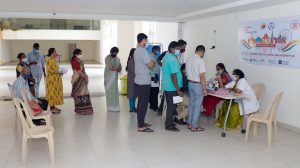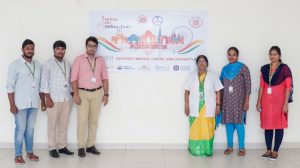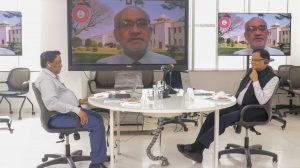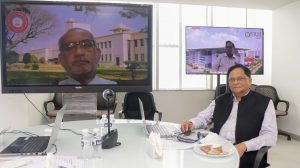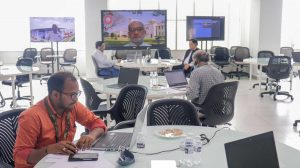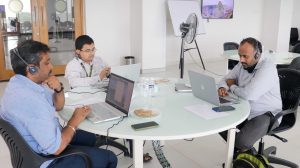SRM-AP All News
ALL News
- Image retrieval scheme with object detection and quantised colour histogram September 30, 2021
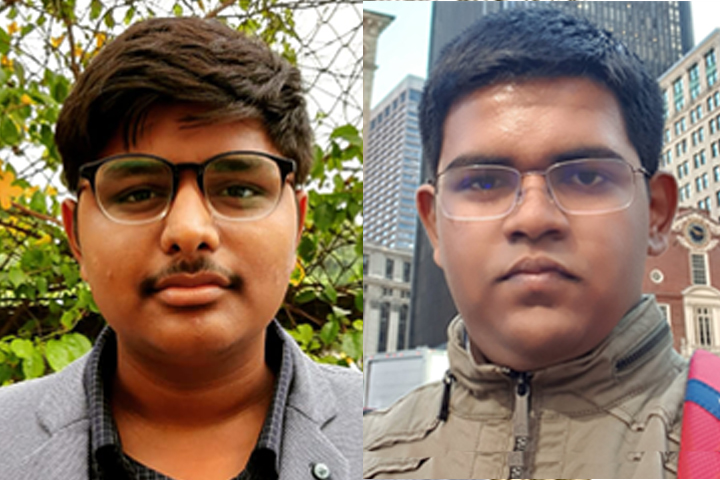 Yuvaraj Tankala and Joseph K Paul, 5th-semester B Tech Computer Science and Engineering students of SRM University-AP, Andhra Pradesh, India has worked with Dr Manikandan V M, Assistant Professor in Computer Science and Engineering Department on a research project and their research paper “A Content-based Image Retrieval Scheme with Object Detection and Quantized Color Histogram” got accepted for publication in the International Journal of Computational Science and Engineering.
Yuvaraj Tankala and Joseph K Paul, 5th-semester B Tech Computer Science and Engineering students of SRM University-AP, Andhra Pradesh, India has worked with Dr Manikandan V M, Assistant Professor in Computer Science and Engineering Department on a research project and their research paper “A Content-based Image Retrieval Scheme with Object Detection and Quantized Color Histogram” got accepted for publication in the International Journal of Computational Science and Engineering.Content-based image retrieval (CBIR) is an active area of research due to its wide applications. Most of the existing CBIR schemes are concentrated to do the searching of the images based on the texture, colour, or shape features extracted from the query image. In this manuscript, we propose an object detection based CBIR scheme with quantized colour histograms. In the proposed scheme, the meaningful objects will be identified from the query image by using you only look once (YOLO) object detection techniques and the quantized histograms of each of the object categories. The object lists, their count, and the area covered by the objects along with quantized colour histograms will be used during feature matching to retrieve the related images from the large image pool. The experimental of the proposed scheme is carried on the Corel 1K and Caltech image dataset. We have observed an average precision of 0.96 during the experimental study which is quite high while comparing the precision from the well-known existing schemes.
To retrieve relevant images from a large image pool, we use content-based image retrieval (CBIR) schemes. In a CBIR scheme, the properties of the query image will be matched with the properties of the images in the image pool. The images which are very close to the given query image will be returned by the CBIR scheme. Most of the existing CBIR schemes use colour, shape and texture properties for image comparison. In the proposed scheme, we use an object detection-based approach with quantized colour histograms to retrieve the relevant images from the image pool.
The real-life applications of the proposed scheme are listed below:
● In the fashion designing and textile industry, CBIR systems can be used to find the existing designs.
● The CBIR systems are useful in crime prevention by retrieving similar crime scenes or the images of criminal persons based on the query image.
● Professional web designers or poster designers want to retrieve relevant images depends on the specific context that they are working.
● To retrieve similar medical images with the relevant treatment details in a computer-assisted diagnosis system.The team currently continue their research work in the same domain to come up with a content-based image retrieval system that will return the relevant images by understanding the relationships among the objects in the image. The classes of the objects in the scene and their properties also will be considered along with the relationship between the objects in the scene.
Continue reading → - SRM University-AP joins in One Nation, One Day, One Million Blood Sugar Tests September 30, 2021
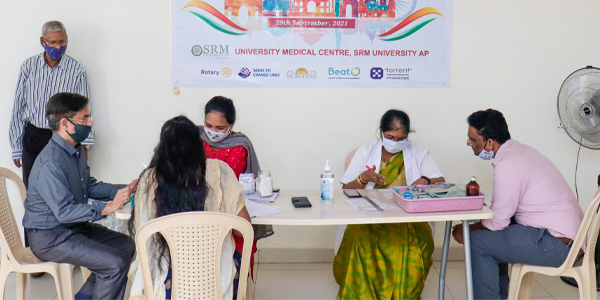 SRM University-AP organised a medical camp, “One Nation, One Day, One Million Blood Sugar Tests”, to spread awareness on Diabetes on World Heart Day on September 29, 2021. The camp was conducted in collaboration with the Research Society for the Study of Diabetes in India (RSSDI).
SRM University-AP organised a medical camp, “One Nation, One Day, One Million Blood Sugar Tests”, to spread awareness on Diabetes on World Heart Day on September 29, 2021. The camp was conducted in collaboration with the Research Society for the Study of Diabetes in India (RSSDI).Every year on September 29, World Heart Day is observed to raise public awareness about heart disease. One of the primary causes of death from a heart attack is diabetes. India is considered the “Diabetes Capital of the World” since it is home to an estimated 74 million diabetics. Prediabetes affects almost the same number of persons as diabetes. According to various studies, 50 per cent of Indians are undiagnosed, and only 25% of those who are diagnosed are adequately regulated.
Research Society for Study of Diabetes (RSSDI) in India has attempted for the Asia Book of Records for the largest number of blood glucose testing in one single day on September 29, 2021, as a diabetes awareness drive named ONE NATION, ONE DAY, ONE MILLION TESTS. As a part of this, the medical team of SRM University-AP conducted a Diabetes screening test for all the staff, faculty and their family members from 10.00 am – 4.00 pm on the day. Dr Ch Lakshmi Rajyam, Medical Officer of the university, commenced the camp.
Diabetes is a major illness that affects the way our body converts food into energy. When your blood sugar levels rise, your pancreas is prompted to release insulin. Insulin functions as a key, allowing blood sugar to enter our cells and be used as energy. If one has diabetes, the body either does not produce enough insulin or does not use it as effectively as it should. Too much blood sugar persists in the bloodstream when there isn’t enough insulin or when cells stop responding to insulin. Over time, this can lead to major health issues like heart disease and vision loss.
Continue reading → - Integration of Science, Engineering and Technology is the key to sustainable development September 29, 2021Continue reading →
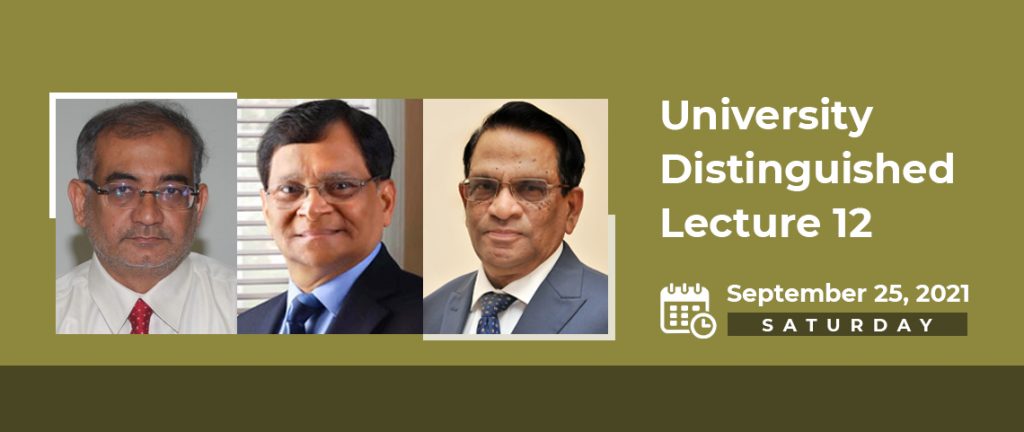 The 12th edition of the widely popular University Distinguished Lecture Series delved into the pertinent relationship between Science, Engineering and Technology. During the distinguished lecture, “Science-Engineering-Technology Synergy for Sustainable Growth”, Prof Indranil Manna well explained the correlation between the streams and how scientists, engineers and industry experts should work together for maximum societal benefits. Prof Indranil Manna, a JC Bose fellow of DST, is currently the Vice-Chancellor of BIT Mesra. The event took place on September 24, 2021, in virtual mode.
The 12th edition of the widely popular University Distinguished Lecture Series delved into the pertinent relationship between Science, Engineering and Technology. During the distinguished lecture, “Science-Engineering-Technology Synergy for Sustainable Growth”, Prof Indranil Manna well explained the correlation between the streams and how scientists, engineers and industry experts should work together for maximum societal benefits. Prof Indranil Manna, a JC Bose fellow of DST, is currently the Vice-Chancellor of BIT Mesra. The event took place on September 24, 2021, in virtual mode.In his address, Prof Indranil Manna asserted that India is no longer a poor country but a mighty economic power with a 3 trillion dollar economy. “We are considered as one of the strongest nations of the world today, not because of the population or because of the youth living in the country, but we are the ones who could send mission to mars at the cheapest cost, and also successfully identified the existence of water on the surface of the moon. Further, we are one of the very few nuclear harnessing nations of the world,” said Prof Manna.
Science began its journey in order to find out the truths of nature. “Why?”- this question is the driving force behind Science. Though Science unravels nature and truth primarily through curiosity or need inspired acts, and the occasional outcome is significant earth-breaking discoveries, sometimes it needs technology to prove it. On the other hand, Engineering deals with “How?” and for Technology, the question is “What?”. Engineering produces certain products and devices by specific designs and inventions. However, what is absolutely essential for the society is Technology, knowledge through the path of knowing ‘why’ and ‘how’ to know ‘what’ sells. Thus, Prof Manna prescribes SET, a conjugation of Science+Engineering+Technology, as the way forward for maximum societal benefits.
Prof Manna explained that innovation means new ideas, creative thoughts, new imaginations in the form of a device or method. It is incremental, cross-disciplinary, directed and translational. Innovation matures itself via Engineering or Technological interventions. Further, sustainability is a composite concept that means the ability to maintain the desired rate or level, avoiding depletion of resources, energy or disturbing the related ecosystem.
Engineering and Technology are the key factors to sustainability. Engineers are not technicians meant only for routine production, maintenance or testing. Instead, Engineering applies the principles of science and logic to develop viable solutions to societal aspirations and challenges. The core of engineering lies in the translation, fundamental concepts to design, develop, fabricate, exploit, analyse, model, stimulate and predict,” Prof Manna elaborated.
Government of India’s Technology Vision-2035 focuses on developing the quality of life of each Indian. Science is pursuing the truth relentlessly regardless of its necessity or immediate scope of application. It provides clues, if not answers and extends as far as imagination goes. Engineering is all about enabling and providing solutions borrowing from the fundamentals of science. Technology is the last mile for societal benefit, based on scientific discovery and engineering inventions and innovations.
India is a great innovator and showcasing continuous gradual progress in it. In the Global Innovation Index (GII), India ranks 48 (2020), making it into the top 50 for the first time. Prof Manna believes that India has enough talent and potential to make it into the top 10. “Let us ensure that Science-Engineering-Technology in India complement each other and flourish together so that our society soon achieves the desired culture, growth and prosperity,” Prof Manna Concluded.
In his welcome address, Prof D Narayana Rao, Pro-Vice-Chancellor, SRM University-AP, said that the development and use of Science & Technology are critical for the achievement and sustenance of various sectors. The importance of Science and Technology to modern society and the role of the technologically educated population in promoting social and environmental developments have long been recognised. Science and technology are considered the most effective means to enhance the growth and socio-economic developments of nations. Moreover, the universalism of science and the globalisation of technological production and trade offer unprecedented opportunities for focused cooperation for scientists, engineers and the institutions that employ them to further progress in sustainable development. Even, National Education Policy-2020 advocated multidisciplinary, multi-institutional research for sustainable development.
In his concluding remarks, Prof V S Rao, Vice-chancellor, SRM University-AP, congratulated Prof Indranil Manna on delivering such a motivating lecture. He further honoured him by presenting a memento.
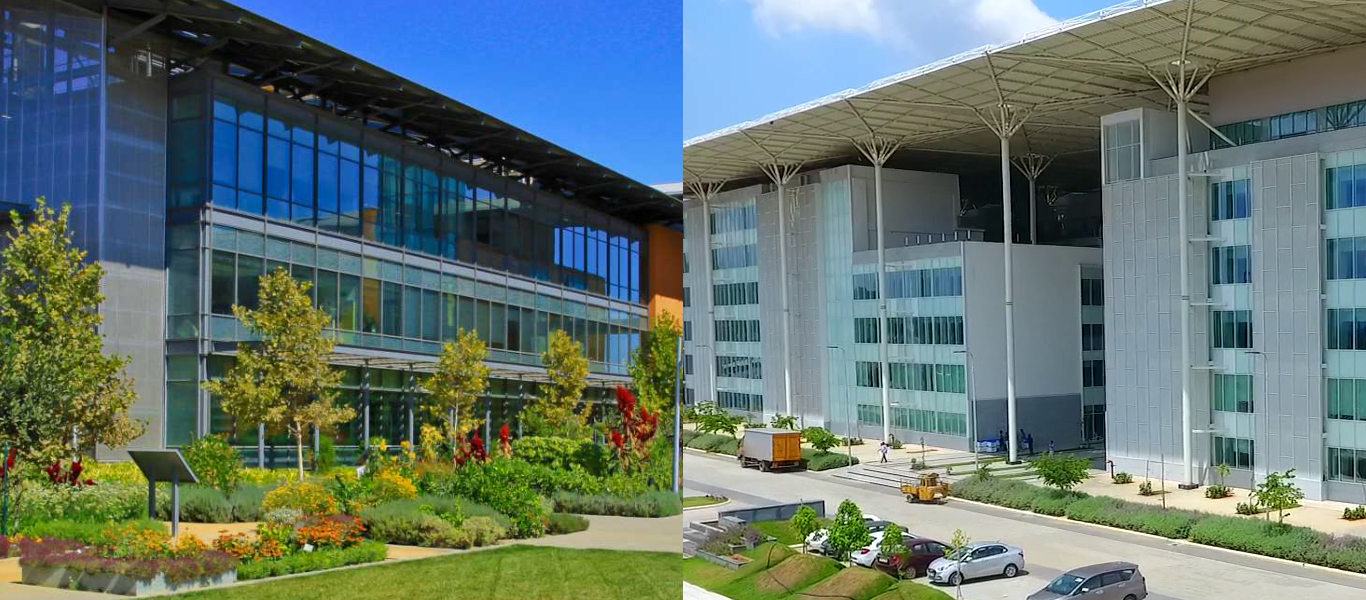 SRM University – AP enters into an MoU with the University of California, Davis for common interests and objectives in academic, scientific, and cultural affairs. Our university will select meritorious students with high academic standing and demonstrated skills for University-level study in English for the Global Study Programme. Prof Y Sivasankar from the Department of Electronics and Communications Engineering will act as the nodal faculty establishing channels of communication to facilitate intellectual interaction.
SRM University – AP enters into an MoU with the University of California, Davis for common interests and objectives in academic, scientific, and cultural affairs. Our university will select meritorious students with high academic standing and demonstrated skills for University-level study in English for the Global Study Programme. Prof Y Sivasankar from the Department of Electronics and Communications Engineering will act as the nodal faculty establishing channels of communication to facilitate intellectual interaction.
The Global Study Programme will enable students to enrol in courses at UC Davis for academic credit that will be applied towards the degree the student is earning at SRM University-AP. Students will be able to enrol in a broad range of courses in nearly all the colleges and departments in UC Davis. They will be provided with access to UC Davis facilities and privileges, including but not limited to: libraries, sports, and recreational facilities, the university transportation system, and the student health centre. Moreover, students will be assisted to obtain housing within a reasonable distance of the UC Davis campus.
The MoU provides a framework for students from SRM University-AP to study at UC Davis under the auspices of the Global Study Programme. The UC Davis Global Study Programme is an academic study programme that allows students from select foreign institutions to enrol in regular UC Davis courses on a full-time, non-degree basis. SRM University-AP initiates global partnership with reputed international universities to facilitate the academic and cultural enrichment of our students which in turn adds to their personal and professional growth.
Continue reading → Dr Anil K Suresh, Associate Professor, Department of Biological Sciences, and his team from SRM University-AP recently developed a see-through transparent (with 85% above transmittance) biotemplate which they derived from the fish scale wastes to substitute the extensive usage of eco-unfriendly disposal plastic cuvettes for UV-Visible Spectroscopy measurements in the spectrum of 350-900 nm. UV-Vis spectroscopy is a versatile analytical tool used to examine the nature of various synthetic, biological and clinical molecules for pharmaceutical and environmental applications. The team members demonstrated the practical on-biotemplate analysis of diverse analytes such as DNA, proteins, nanoparticles, organic dyes, bacteria, BSA assay and dye-degradations.
Dr Anil K Suresh, Associate Professor, Department of Biological Sciences, and his team from SRM University-AP recently developed a see-through transparent (with 85% above transmittance) biotemplate which they derived from the fish scale wastes to substitute the extensive usage of eco-unfriendly disposal plastic cuvettes for UV-Visible Spectroscopy measurements in the spectrum of 350-900 nm. UV-Vis spectroscopy is a versatile analytical tool used to examine the nature of various synthetic, biological and clinical molecules for pharmaceutical and environmental applications. The team members demonstrated the practical on-biotemplate analysis of diverse analytes such as DNA, proteins, nanoparticles, organic dyes, bacteria, BSA assay and dye-degradations.
Dr Anil claims that the large-scale development of the biotemplate can resolve several issues in performing sustainable research; for instance, generates huge demand for fish scales as a resource stratagem otherwise causative of foul smell and disease propagation when discarded. Second, the use of non-biodegradable plastic cuvettes can be minimized for routine analytics and third, unlike plastic cuvettes that demand 500-fold analyte our biotemplate allows the analysis at a very low 10 microlitre volumes, making it feasible to analyse expensive, rare, and high-risk analytes. Dr Anil K Suresh owns the copyrights for this pathbreaking invention by being granted an Indian patent. This work is accepted for publication in the prestigious Journal of “Green Chemistry” by the Royal Society of Chemistry. Read the full paper here.
Adding to the mechanistic, Dr Anil said, “naturally acquired droplet retaining ability for over 30 minutes against gravity while vertically positioning the biotemplate supported such ultra-low volume measurements and monitoring of chemical reactions in-situ”. Interestingly, the same ability allows the retrieval of the analytes after completion of the analysis, crucial for precious analytes. Dr Anil says the best part is that the transparent biotemplate can be discarded back into the environment post-usage without any hesitation as the biotemplate is completely biodegradable.
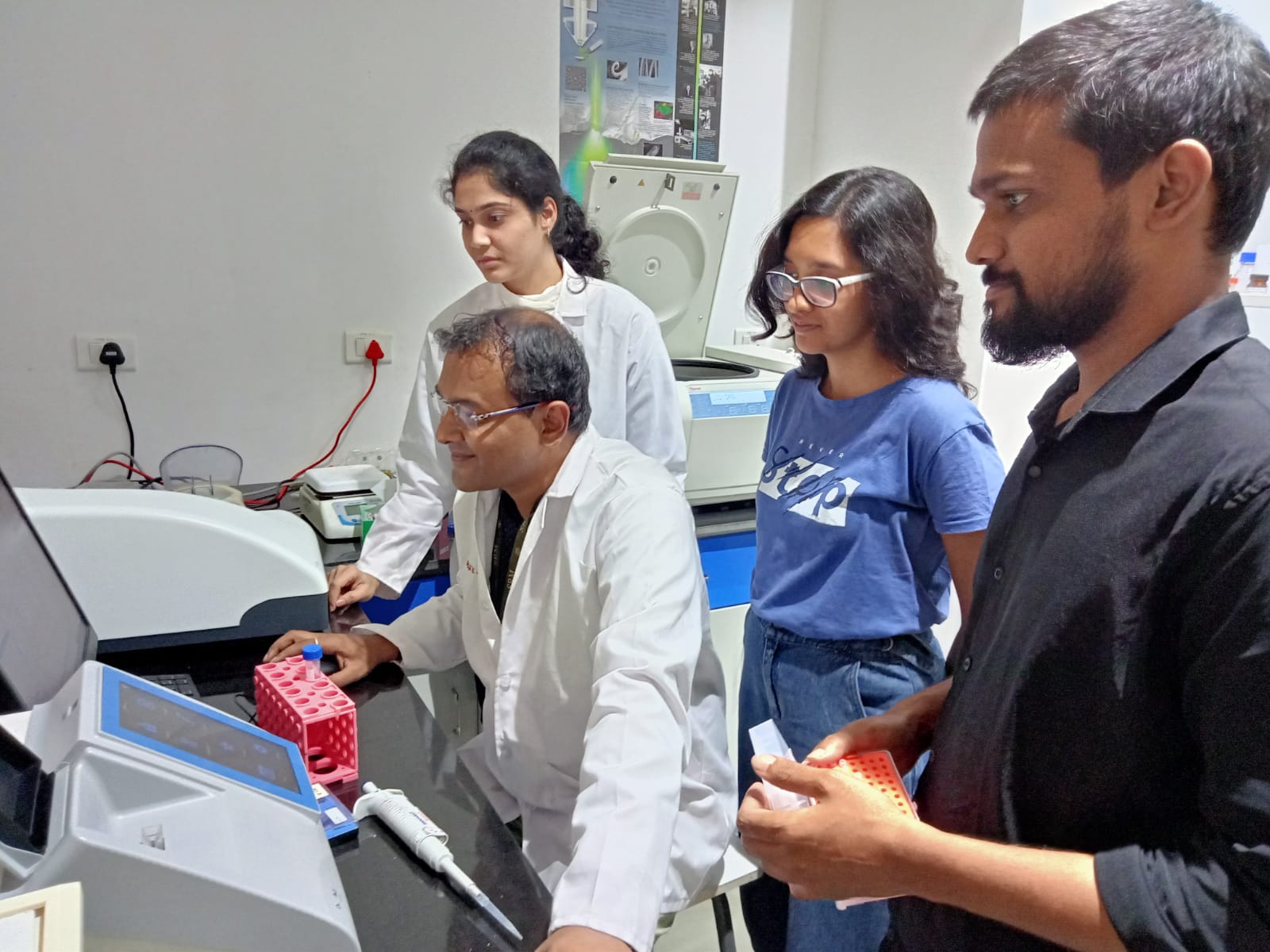
Further, the research group demonstrated ease in large-scale production by generating ~3000 bio templates at an affordable price. Dr Anil emphasised that this low-cost, plastic-free, use-and-throw biodegradable transparent biotemplate stemmed from food waste as a bioresource stratagem has huge potential in routine scientific and pharma UV-Vis analytics and he will very soon bring this product to the scientific community as a sustainable science solution.
Dr Anil Suresh concluded that this breakthrough conception would not have been possible without the rigorous efforts of his team and the continuous support from the university management, who are also encouraging and willing to support Dr Anil to establish his own start-up within the University. Dr Anil Suresh thanked his group members Ms Divya Parimi, Mr Chandra Bhatt, Mr Tharun Bollu and Ms Madhura, his collaborators Dr Malli and Mr Jacob. Dr Anil’s team especially thanked the management of SRM University-AP; the President Dr P. Sathyanarayanan for his generous support, Prof D Narayana Rao, Pro-Vice-Chancellor for his constant untiring encouragement, motivation and support in all his scientific endeavours, and the Vice-Chancellor Prof V S Rao for his kind support.
Continue reading →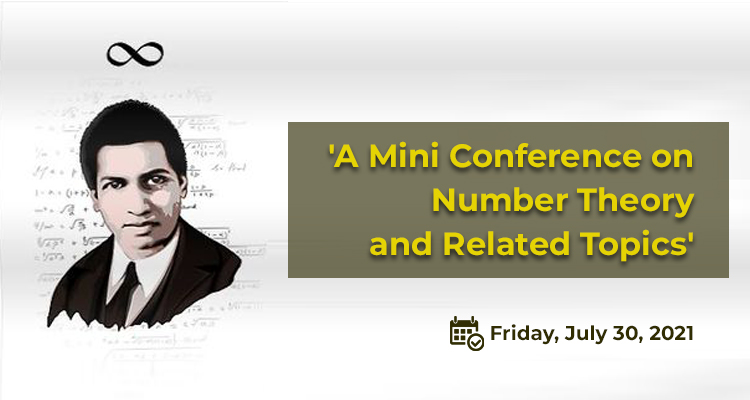 Department of Mathematics, SRM University-AP organised a 3-day conference on Number Theory and Related Topics. The Conference was scheduled for July 30 – August 01, 2021. Distinguished speakers from IMSC Chennai, CMI-Chennai, IIT-Kanpur, Ropar, Indore, Gandhinagar and Delhi, IISER-Bhopal, Pune and Tirupati, Charles University, Prague, University of Zagreb, RKMVERI, Belur took part in the Conference and presented their work and ideas on Number Theory.
Department of Mathematics, SRM University-AP organised a 3-day conference on Number Theory and Related Topics. The Conference was scheduled for July 30 – August 01, 2021. Distinguished speakers from IMSC Chennai, CMI-Chennai, IIT-Kanpur, Ropar, Indore, Gandhinagar and Delhi, IISER-Bhopal, Pune and Tirupati, Charles University, Prague, University of Zagreb, RKMVERI, Belur took part in the Conference and presented their work and ideas on Number Theory.
Modern number theory is connected with almost every other branch of mathematics. This Conference is dedicated to exploring different aspects of modern number theory, including modular forms, automorphic forms, representation theory, arithmetic geometry, special functions, diophantine approximations, quadratic forms etc. This Conference aims to encourage young aspiring mathematicians to get a flavour of the broad horizon of number theory.
For more information and to watch the lecture videos, please visit this site.
Continue reading →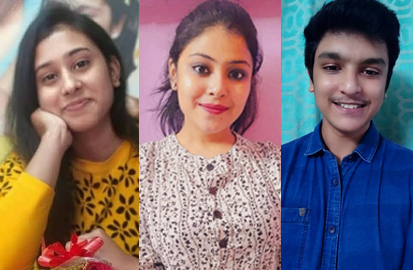 Swikriti Khadke, Pragya Gupta, and Shanmukh Rachakunta from third-year Computer Science Engineering have published a research paper titled “Efficient Plastic Recycling and Remold Circular Economy using the Technology of Trust – Blockchain” along with their mentors from SRM University-AP Dr Jatindra Kumar Dash, Dr Goutam Kumar Dalapati and Dr Sabyasachi Chakrabortty in the peer-reviewed journal Sustainability.
Swikriti Khadke, Pragya Gupta, and Shanmukh Rachakunta from third-year Computer Science Engineering have published a research paper titled “Efficient Plastic Recycling and Remold Circular Economy using the Technology of Trust – Blockchain” along with their mentors from SRM University-AP Dr Jatindra Kumar Dash, Dr Goutam Kumar Dalapati and Dr Sabyasachi Chakrabortty in the peer-reviewed journal Sustainability.
Global plastic waste is increasing rapidly. The strategic management of plastic waste and recycling can preserve environmental species and associated costs. The utilization of plastic can be done by introducing Blockchain during plastic waste recycling. Automation for the segregation and collection of plastic waste can effectively establish a globally recognizable tool using Blockchain-based applications. Collection and sorting of plastic recycling are feasible by keeping track of plastic with unique codes or digital badges throughout the supply chain. Efficient recycling technology is essential to reduce plastic pollution. Many technologies have been employed to enhance plastic recycling. Among them, blockchain is promising for plastic recycling and circular economy (CE). Blockchain, a distributed ledger, consists of some ordered blocks which are unchangeable. This can be considered an exemplary way to push the transactions of their customers under the same blockchain technology. The research group used machine learning techniques to predict plastic generation globally so that they could see the impact it will make in the coming future. The students have used ARIMA – Auto-Regressive Integrated Moving Average for the study.
The potential idea is to utilize an approach wherein recyclers can keep track of generated waste as it moves through the various chains. A platform that works by tracking recycling activities across a local recycling supply chain on the Blockchain. When this will be publicly available, consumers can also use the ledger info to make more informed purchasing decisions. The Blockchain can be utilized to track individual items through the recycling supply chain by creating physical markers like QR codes.
The suggested Blockchain-based platform can be implemented in various nations with an autonomous waste collector and storage system. This process can be expanded to individual collectors and storage systems. The novel process will be created by incorporating a reward-based Blockchain scheme with the collaboration of global businesses and local waste collectors. The proposed model further allows the effective sharing of databases among various supply chains to create a CE.
Talking about the social implications of the research, the students firmly believe that the study will result in the introduction of new technology in the recycling industry and promote awareness about technology in rural areas. Developing a platform and implementing blockchain and other facilities will be the focus of these young innovative brains of SRM University-AP in the forthcoming days.
Read the full paper here: https://doi.org/10.3390/su13169142
Continue reading →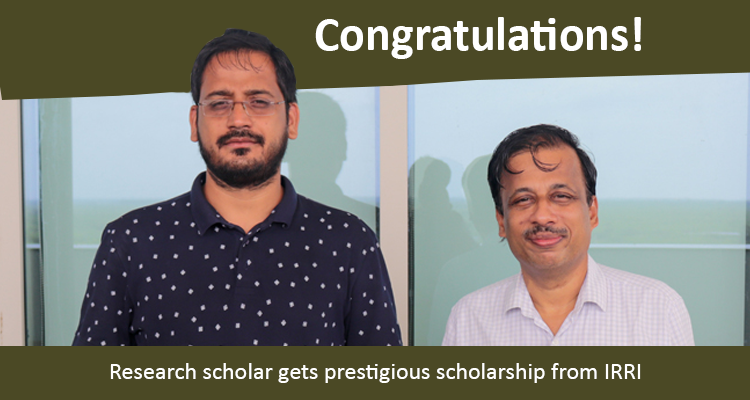 A Doctor of Philosophy (PhD) student of the Department of Biological Sciences at SRM University-AP, Andhra Pradesh, Faraz Azeem, has been awarded a prestigious scholarship by the International Rice Research Institute (IRRI), Manila, Philippines. The scholarship will enable Faraz to carry out a part of his PhD research under the supervision of Dr Jauhar Ali, Senior Scientist-II, Head – Hybrid Rice Development Consortium (HRDC), Leader – Hybrid Rice Breeding Cluster, Rice Breeding Platform, International Rice Research Institute, Los Banos, Philippines, for a period of one year and four months.
A Doctor of Philosophy (PhD) student of the Department of Biological Sciences at SRM University-AP, Andhra Pradesh, Faraz Azeem, has been awarded a prestigious scholarship by the International Rice Research Institute (IRRI), Manila, Philippines. The scholarship will enable Faraz to carry out a part of his PhD research under the supervision of Dr Jauhar Ali, Senior Scientist-II, Head – Hybrid Rice Development Consortium (HRDC), Leader – Hybrid Rice Breeding Cluster, Rice Breeding Platform, International Rice Research Institute, Los Banos, Philippines, for a period of one year and four months.
Faraz joined SRM University-AP, Andhra Pradesh, in January 2021 and is working on “Understanding the genetics and molecular biology of nitrogen-use efficiency in rice” under the guidance of Prof Jayaseelan Murugaiyan, HoD, Department of Biological Sciences, SRM University-AP. Dr P Sathyanarayanan, President; Prof V S Rao, Vice-Chancellor; Prof D Narayana Rao, Pro-Vice-Chancellor of SRM University-AP congratulated Faraz for this accomplishment.
The International Rice Research Institute (IRRI) is a global agricultural research and training organisation with offices in seventeen countries and headquarters in Los Banos, Laguna, Philippines. IRRI is well-known for its role in producing rice varieties that contributed to the 1960s Green Revolution, which helped Asia avoid famine. The CGIAR Consortium of International Agricultural Research Centres, a global alliance of institutions involved in food security research, includes 15 agricultural research centres worldwide. The International Rice Research Institute (IRRI) is one of the Asia’s largest non-profit agricultural research facility.
SRM University-AP provides a wide array of opportunities and benefits along with its PhD Programmes. The nascent university has more than 150 PhD students to date in various departments of Engineering, Science, Liberal Arts, Business Administration and Social Sciences. SRM University-AP university has a vibrant research environment with state-of-the-art facilities along with attractive fellowship and complimentary food and accommodation at the university campus. The faculty advisers have paramount knowledge and experience in research along with international exposure. The university also provides support for journal publications, patent filing, and attending national and international conferences.
SRM University-AP further has MoUs with reputed universities abroad for Student Exchange Programme. In addition, the university is conducting research projects funded by prominent organisations, industries and the Government of India. Research projects sponsored by DST, DST-NSM, DBT, DBT-Wellcome Trust, UGC-DAE, ARBL, Titan industries etc are a few of the current ongoing projects.
Continue reading →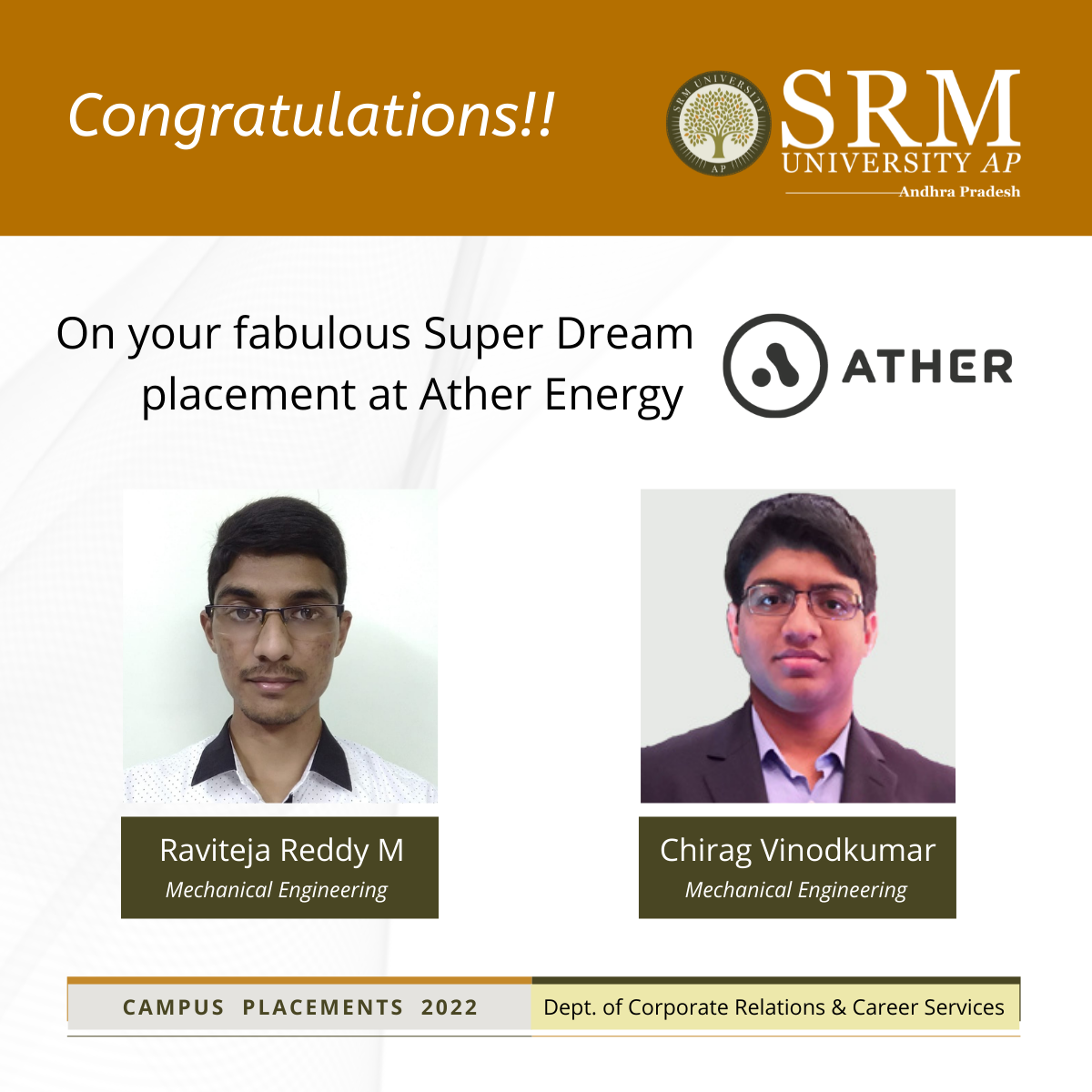 Chirag Vinodkumar Menon and Mudireddy Raviteja Reddy, two vibrant students from the Department of Mechanical Engineering, have been placed in Ather Energy with a CTC of ₹10.00 LPA. The Ather 450Xur and Ather 450 Plus are two electric scooters that the company manufactures. Tarun Mehta and Swapnil Jain established Ather Energy Pvt. Ltd., an Indian electric car startup, in 2013. It has also founded the Ather Grid electric vehicle charging infrastructure across the country.
Chirag Vinodkumar Menon and Mudireddy Raviteja Reddy, two vibrant students from the Department of Mechanical Engineering, have been placed in Ather Energy with a CTC of ₹10.00 LPA. The Ather 450Xur and Ather 450 Plus are two electric scooters that the company manufactures. Tarun Mehta and Swapnil Jain established Ather Energy Pvt. Ltd., an Indian electric car startup, in 2013. It has also founded the Ather Grid electric vehicle charging infrastructure across the country.
Let’s look into what our students say about their placement experience!
Chirag Vinodkumar Menon
For me, this job offer from Ather Energy is a dream come true. This is everything I ever expected for my first job and I can’t be happier. As soon as I saw the job offer, I started to prepare for my logic and technical assessment. The coursework provided by CDC was very helpful and the domain training lessons provided by the college helped me cinch the assessments. After I received news that I am selected for the technical interview, I immediately started focusing on my projects, which are innovative and relevant, as a result of repeated consult with the esteemed faculty of SRM University-AP. Their guidance is a vital reason why my projects have been a success, despite remotely working due to the pandemic. I consulted with my teammates and friends as well and as a result of efforts and determination, I have been able to crack the final HR interview.
The mock interviews conducted by the CR&CS department helped me refine my answers and my personality as a suitable candidate. My mother also helped me immensely to prepare for my interviews. I thank the CR&CS department for choosing reputed companies and giving me a chance to apply for this job opening and for ensuring the process is as smooth as possible. I would like to wish the very best for all my peers and juniors, success in their professional and educational endeavours.
Raviteja Mudireddy
I’m very excited and happy in receiving the job offer from Ather Energy. From the beginning of my B Tech itself, I have had much interest and passion towards automobiles which actuated me to do many projects. This in turn helped me in gaining knowledge in Electric Vehicles and added extra weight to my resume. I extend my gratitude to SRM University-AP for supporting my projects by providing technical assistance and monetary help beyond measure. The Mechanical Engineering curriculum is diversified and helped me gain knowledge in fields like Manufacturing Technology, 3D printing, etc. Of course, my research in EV (Electric Vehicle) Tech has also helped me a lot.
I thank the Placement department for bringing Ather Energy to our campus and guiding me to the HR Round. My message to my juniors in Mechanical Engineering is that the projects and the research work in the undergraduate coursework will differentiate a student from the rest of the crowd. Projects are not just for the marks or grades, they will lead you to get your dream job or even help you to start your own company.
Karl-Alexander Seidel at Freshers Orientation 2021, SRM University-AP
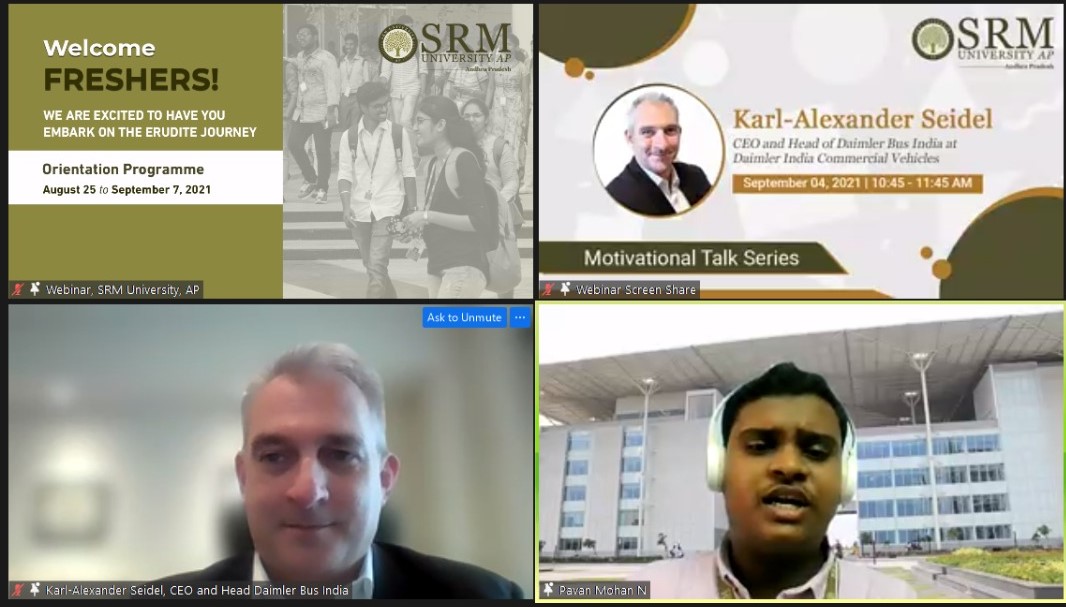
Mr Karl-Alexander Seidel, CEO and Head of Daimler Bus, India at Daimler India Commercial Vehicles interacted with the freshers of SRM University-AP in a session organised as part of the Orientation 2021. In his address to the students, Mr Seidel recollected his university days, love for automotive and the challenges he faced in contributing to Euro 6 emission standards.
While answering a question put forward by students, Mr Seidel said that strong theoretical knowledge along with interpersonal skills such as teamwork which lead to cocreation is what he appreciates in job seekers. As the CEO of a company that is a subsidiary of German multinational automotive corporation Daimler, he said he would recruit people who have a vision, creativity and pioneering spirit wanting to do something bigger and better. “I see electric vehicles as the future of India. The infrastructure required for driverless cars is currently a challenge in Indian cities” Mr Seidel said. “If you can come up with solutions to make autonomous driving happen in India, our company will be happy to have you on board”, he added, encouraging the inquisitive minds of SRM University-AP.
Vice-Chancellor Prof V S Rao recollected his industry visit to Daimler in Germany and how impressed he was about the perfection of the workers and the discipline that ensures quality. He expressed his interest in conducting online research internships with the best companies and facilities abroad in association with Daimler India Commercial Vehicles. Mr Vivekanandan, Associate Director, Department of Corporate Relations and Career Services expressed his sincere gratitude on behalf of the university. “We are extremely glad that Mr Seidel could inspire the freshers and incite dreams for an innovative future”, he added. Mr Laxmanan Angu Raju, Senior Manager from the Department of CR&CS was present during the occasion.
Continue reading →


